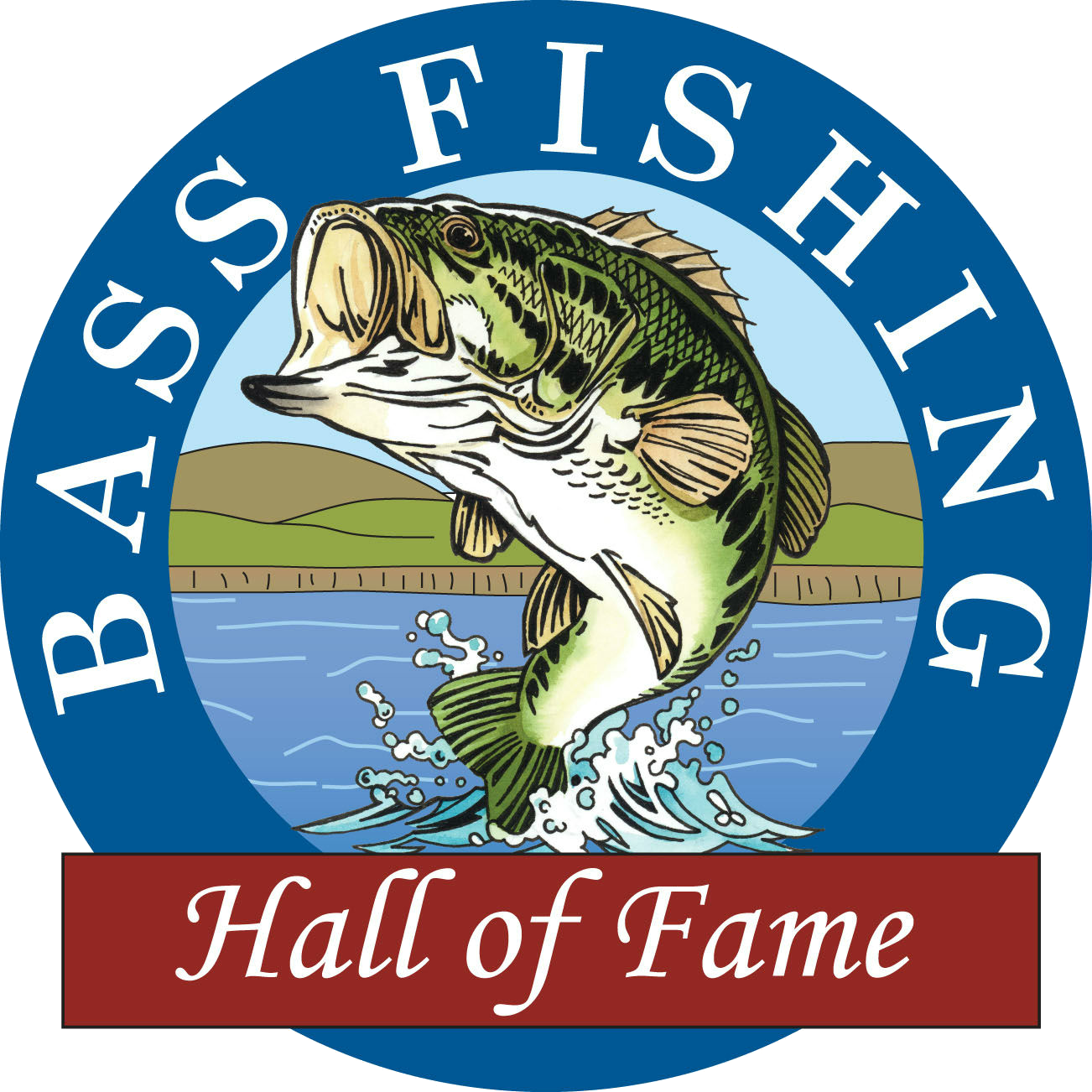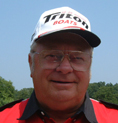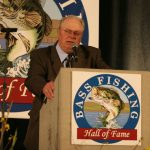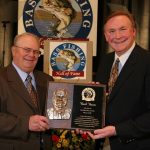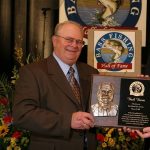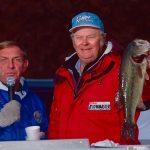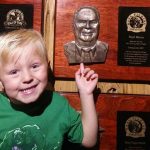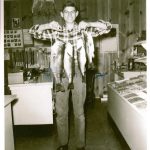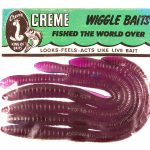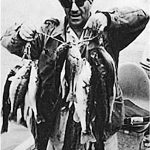Bill Norman
The late Bill Norman established a name for himself by building an internationally known fishing lure company, Norman Lures company in Greenwood, Arkansas.
Many people have created fishing lures that caught fish, but few have also had the ability to hook fishermen first. Over his 20 year career, Norman had the ability to anticipate and predict the future of bass fishing and capitalize on it, to the benefit of the explosive bass fishing industry.
Norman brought his boyhood love of fishing into his adult life when, after serving in the military and some early work years, he took his fishing interest into a business venture with Wood Lures, a Conway, AR, firm.
While Wood Lures had a proven track record selling a lure called the Spottail Minnow lures that were made of cedar, balsa, and other woods were giving way to plastic lures in the late 1960s and early 1970s.
It was about this time that Norman joined the Fort Smith firm that became Plastics Research and Development Company (PRADCO), where his experience with assembly line methods worked well with other company employees knowledge of plastics. It was also the heyday of the alphabet bass lures. The pioneer Big O, carved from wood, shifted to plastic and drew rivals called the Super R and later, Norman’s Big N.
When Bill Norman left PRADCO, he moved a few miles south to Greenwood and built Norman Manufacturing. His moved coincided closely with the rapid growth of organized bass fishing and the debut of bass tournament fishing as a sports vocation.
Being an early pioneer, Norman looked at major bass tournaments as a route to get his lures before the general public. He was among the first, if not the first, to sponsor a Pro Team of professional anglers on the national bass circuits and he competed himself in some of the early BASS events.
Throughout his life Bill Norman successfully assembled a staff of innovators and pushed hard to remain a step ahead in the changing fishing world, and today his Norman Little ‘N; DD22; the Tiny ‘N and N-Ticer are standards in many anglers tackle boxes around the world.
Bill Norman
Stan is one of the pioneers of bass fishing in the western United States. No one in that part of the country has written more about bass fishing. He began writing immediately after returning from almost two years of serving in an infantry rifle company in the jungles of the South Pacific during World War II. He has been at it ever since.
Stan is an award-winning outdoor writer who has written for a variety of prestigious publications including Bassmaster, Bassin, Field & Stream, Outdoor Life, Sports Afield and many others. He has written countless newspaper columns. Most of his writing is currently appearing in four different Internet columns.
Stan is equally recognized for his artistry with a rod. Known internationally as “The Master Caster,” he has been featured in outdoor shows since 1952. His skills with casting and spinning equipment have taken him from Tulsa to Tokyo and from Birmingham to Brazil. Years ago Covey Bean, an outdoor writer for the Sunday Oklahoman, wrote: “When Stan Fagerstrom talks casting, people listen.” Decades have passed since those words were written, but today folks still watch and listen as this white-haired wonder works his casting magic.
Stan’s casting has been featured in a variety of television shows both here and abroad. He was, for example, a guest on the Jo Soares evening program while appearing at an outdoor show in Sao Paulo, Brazil. Soares is often called the “David Letterman of South America.” Stan also gave a private casting demonstration for Japan’s Princess Nobuko while participating in a major outdoor show in Tokyo.
Stan was the only writer from the Pacific Northwest invited to the first Bassmasters Classic at Lake Mead. He covered more than 30 Classics for a variety of publications in ensuing years. When Stan wasn’t riding along with a Classic competitor, he was giving casting demonstrations at the Classic Outdoor Show.
Fagerstrom has won numerous awards for his writing. Some of his poetry dealing with fishing has been widely published in both printed media and on the internet. Besides his newspaper and magazine work, he has written three books on fishing and starred in two instructional videos on casing.
Stan does more than write about fishing. Early in his career he participated in the Oregon Bass & Panfish Club’s annual “Biggest Bass Contest.” He won all five years in which he competed. Stan is a long time member of the Outdoor Writers of America and a charter member of the Northwest Outdoor Writers Association. He has been inducted into the National Freshwater Fishing Hall of Fame. In 2001 he was presented with the National Professional Anglers Association’s Honorary Lifetime membership award.
Watch one of Stan’s casting exhibitions and you’ll hear him say the same thing each time he winds up. It’s this: “The next best thing to fishing is having a chance to write or talk about it. I thank you and I thank God for giving me another opportunity to do that here today.
Mr. Fagerstrom passed away at the age of 96 in June 2019
Stan Fagerstrom
Basil Bacon (1937—) Basil was the first person to design a “flippin’” button on a baitcasting reel. The “flippin’” button, which is now standard equipment on just about every freshwater baitcasting reel in the world, helped anglers learn the new “flippin” technique that was being developed back in the early-to-mid 70’s.
In addition to the “flippin’” button, Bacon was also a pioneer in developing the raised “flippin’” deck that is now incorporated on bass boats. Bacon was also the gentleman who invented the four-bladed prop that is so often used to achieve maximum performance on today’s modern bass boats.
But all of Bacon’s expertise is not in the design and manufacture of fishing and marine equipment. Bacon is also one of the finest lure designer’s in American fishing history.
Over the years, Basil has designed such fishing lure classic’s as the Bacon Rind and Bacon Strip soft plastic lures and the Wakin’ Bacon spinnerbait.
Since 1971, when Bacon began fishing along the various professional tournament trails, Basil qualified for nine BASS Master Classics; captured two B.A.S.S. tournament titles; was the Angler-of-the-Year in 1973 and 1974 for the Project Sports Bass Tournament Trail; won two Fisherman’s Bass tournaments; won three Bass Casters Association tournaments; won an Anglers Choice Pro Division Classic and most recently captured the 2002 Wal*Mart FLW Tour Event on Old Hickory Lake, outside of Nashville.
Throughout his distinguished tournament career, Basil Bacon has placed in the Top 10 in more than 40 B.A.S.S. tournaments and has recorded more that 125 Top 10 finishes along the various tournament trails he’s competed on.
- Kinleigh Nicole Preston son, Brant, next to her grandpas hall of fame plaque inside Wonders of Wildlife
Basil Bacon
Virgil, one of nine children, attended grade school in Easton and then moved with his parents to Amsterdam, Mo where he attended high school, graduating in 1931. On December 3, 1933 he was united in marriage to Cleda Irene Thornbrugh and to this union, four children were born. He was a member of the Church of God (Seventh Day). Virgil began his working career by selling, installing and servicing Delco 32 volt light plants after which he owned and managed Ward Electric Company. In 1950 he and his son began the Bass Buster Lure Company in Amsterdam. Virgil was a devout fisherman and built his reputation through several tournament victories including the 1962 World Series of Sport Fishing, the 1964 National Championship of Fresh Water Fishing and the 1964 Outdoor Writers and broadcasters National Fishing Tournament. By 1963, Virgil was writing a column that appeared in 455 newspapers, was host of a radio show on 200 stations and delighted viewers for years with his nationally syndicated television show “Championship Fishing” which was the #1 rated television show for 24 out of 27 years. He belonged to the Outdoor Writers Association, bass Club and American Federation of Television and Radio Association.
Virgil had a great sense of humor and a strong will.. all the way up to the end. He possessed a competitive nature, but was honest and giving. Outdoor pastimes included deer and quail hunting,, and fishing, of course….especially on the private lakes he built on his farm. He enjoyed the companionship of his bird dogs as well. Virgil, a devoted Christian family man, made memorable annual fishing trips to Canada. As one of the nation’s best-known fishermen, Virgil was an everyday person who became a legend, leaving precious memories to family and friends.
Virgil is survived by his wife of 70 years, Cleda Ward.
Virgil Ward
Elwood Lake (Buck) Perry – Widely acclaimed as the “father of structure fishing” – his theories changed the way very serious angler approached the underwater world.
His theories on structure fishing were based on his direct observations of fish behavior. As a lifelong fisherman, he repeatedly observed that fish travel both in schools and along predictable paths between deep and shallow water. These paths are determined by the bottom structure of the lake.
Buck Perry opened up our lakes and rivers to a different style of fishing than anyone before him had ever enjoyed. He was the first to talk about how weather affects the fish, specifically the “cold front”.
In 1946 he invented the Spoonplug lure in his North Carolina garage and the lure has remained on the market for more than five decades. Spoonplugs are lures (tools) specifically designed to find productive structure, locate fish, and make them strike.
Even before the days of sonar, Perry was using his Spoonplugs and trolling tactics to catch deep water and offshore bass that others did not even know existed.
He spent his life educating others about bass migrations, habitat and deep water methods. Perry published Spoonplugging: Your Guide to Lunker Catches in 1973 – considered one of the most influential fishing books ever written. He also published a nine-volume Home Study Series in 1981 and his bi-monthly newsletter, Buck Perry’s The National Spoonplugger, is still published today.
Though he passed away in 2005 at the age of 90, his Spoonplugging school is still a serious educational institution for anglers.
Buck Perry
Nick Creme (1910—1984) invented the modern plastic worm in 1949 while living in Ohio. Nick and Cosma Creme cooked up the perfect combination of vinyl, oils and pigments to produce a molded worm that not only looked and felt soft and alive, but also stayed that way when exposed to air over time. The first marketed worm was the Creme Wiggle Worm. It was sold by mail in 1951 at a cost of $1 for a pack of 5. When the product was shown at the Cleveland Sportsman’s Show, a distributor sold 9,600 in just a few days.
The demand soared and quickly outgrew the kitchen. That’s when the Creme’s set up a small manufacturing plant in Akron, Ohio.
In the late 50s, word of the soft plastic worm began to spread to bass anglers in the South. Crème decided to move his company into the center of the bass activity and built a plant in Tyler, TX. When professional anglers began winning early B.A.S.S. tournaments on Creme Scoundrels and Shimmy Gals, his business really took off.
Nick began to work with avid bass anglers who came up with many product innovations and rigging techniques. Creme was one of the first lure manufacturers to utilize a field staff network, and Nick used expert anglers nationwide to introduce his worms to other fisherman. He also became one of the first companies to sponsor a pro when, in 1967, Nick offered John Powell $18,000 a year to fish Creme worms.
Seldom does one individual in our industry have such a major impact. Nick Creme’s invention of the plastic worm in 1949 actually revolutionized bass fishing.
Nick Creme died in 1984, but today the tradition continues. Creme Lure Company continues to produce the original Scoundrel worm as well as new and innovative products.
